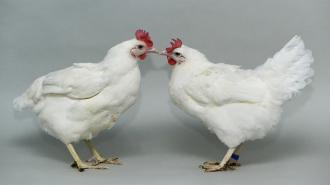Using CRISPR gene-editing technology, UK scientists created chickens that are highly resistant to the avian flu virus — and with a couple more edits, they think the birds will be fully immune.
The avian flu: Since 2022, American farmers have had to kill more than 58 million chickens and turkeys after their flocks became infected with avian influenza, aka “bird flu.” This cost an estimated $1 billion and led to record-high egg prices in 2022.
More concerning than expensive omelets is the fact that each time the avian flu virus spreads, it gets a chance to mutate into a form that would allow it to easily infect people and potentially start a new pandemic.
Since 2022, avian flu has forced US farmers to kill more than 58 million chickens and turkeys.
Several vaccines designed to protect commercial flocks from avian flu are in development, but even if they work, deployment would be a gigantic, expensive challenge — US farmers raised more than 9.3 billion chickens and turkeys for meat alone in 2021. And, just like human flu shots, the poultry vaccines would need to be regularly updated.
“This is a very variable virus, and if you don’t update the vaccine that you’re applying to meet the change in the virus, then you won’t be able to completely protect the birds,” Rodrigo Gallardo, a specialist in avian virology at UC Davis, told CNN.
CRISPR’d chicks: Rather than constantly updating and deploying avian flu vaccines, scientists at the University of Edinburgh, Imperial College London, and the Pirbright Institute are trying to genetically engineer birds that can’t be infected — and they’re getting closer.
On October 10, they published a study detailing how 9 out of 10 of their genetically engineered chickens did not get avian flu when the virus was sprayed into their nasal cavities. Just as important, the one chicken that was infected didn’t spread the virus to any unmodified birds.
“Gene-editing offers a promising route towards permanent disease resistance.”
Mike McGrew
When they sprayed a dose 1,000 greater than what the chickens were likely to encounter normally into their nasal cavities, half of them became infected, but those birds still shed much less virus than unmodified controls.
All of the genetically engineered chickens appeared healthy, and the hens laid eggs normally.
“Gene-editing offers a promising route towards permanent disease resistance, which could be passed down through generations, protecting poultry and reducing the risks to humans and wild birds,” said Mike McGrew, the study’s principal investigator.
Super-birds: From past research, the scientists knew that the avian flu virus needs to use a protein found in the cells it infects (called “ANP32A”) to make copies of itself. For the new study, they used CRISPR to make small edits to the ANP32A gene in chickens, preventing the virus from being able to bind to the protein.
When they studied the gene-edited chickens to figure out how the virus was still able to infect some of them, they discovered that the virus had undergone mutations that allowed it to use two related proteins — ANP32B and ANP32E — to replicate.
The researchers then used CRISPR to completely knock out all three ANP32 genes in lab-grown chicken cells. When they exposed those cells to the avian flu virus, it was totally unable to infect them.
The cold water: Completely knocking out the three ANP32 genes in chickens would likely affect their health, so the researchers will need to figure out how to edit the genes so that they still can make their respective proteins, but the bird flu virus can no longer bind to them.
“I am extremely confident that editing the three genes will give full immunity.”
Mike McGrew
Even if they can do this, the virus could undergo mutations to circumvent those edits, and those mutant versions could potentially help it make the jump from birds to people. Already, some of the mutations seen in the gene-edited chickens allowed the virus to use the human version of ANP32 to replicate in tests on human cells.
On top of all that is the issue of getting the gene-edited poultry approved by regulators and accepted by consumers.
The bottom line: The bird flu could mutate to spread between people whether we genetically engineer chickens or not. If that happens, being able to quickly update avian flu vaccines for people could prevent the situation from evolving into a deadly pandemic.
However, our best chance of avoiding that scenario — and vast losses in the poultry industry — will be preventing the virus’s spread entirely, and the UK researchers are confident they’re on the right track to making that happen.
“When we did these edits in the cells there was no growth of the virus at all. The changes stopped all replication of the flu,” McGrew told BBC News. “I am extremely confident that editing the three genes will give full immunity.”
We’d love to hear from you! If you have a comment about this article or if you have a tip for a future Freethink story, please email us at tips@freethink.com.
